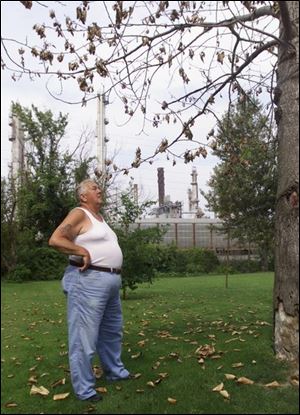
Neighbors' beef with Sunoco is heard
8/11/2003Oil droplets in swimming pools. Oil droplets on houses. Oil droplets on cars.
East Toledo and Oregon residents have been irked for years by what appears to have fallen out of the sky. Others are now taking notice:
The group wants reductions from Oregon's BP refinery too, but is focusing on Sunoco because of its proximity to a residential area and its violation history, Ms. Miringu said. BP is more isolated, near the hazardous waste landfill operated by Envirosafe Services of Ohio, Inc.
wToledo's Division of Environmental Services, on behalf of the Ohio Environmental Protection Agency, has cited Sunoco for more violations since the company agreed to a $200,000 fine and vowed to make improvements in sulfur dioxide emissions in a 1995 consent order with the Ohio Attorney General's Office.

Don Moore said he noticed leaves falling from an otherwise healthy tree, one that faces the Sunoco refinery.
In a warning letter issued Feb. 18, the city accused Sunoco of “excessive malfunctions” last fall. Although Sunoco said it has made improvements and has decreased its releases since 1988, it is defending itself from a lawsuit filed in April, 2002, by the attorney general's office.
Philadelphia-based Sunoco, Inc., is committed to modernizing the Toledo refinery so it can meet tough new U.S. EPA regulations for sulfur dioxide that go into effect in 2005, Olivia Summons, refinery spokesman, said. The refinery is one of four in the U.S. owned by the company, she said.
“The plan right now is to invest heavily in this plant to comply with these regulations,” Ms. Summons said.
Citizen Action's campaign has generated interest - the company has received 2,900 letters recently. Some writers want the refinery to curb emissions while others want it to take more precautions against spills, Ms. Summons said.
Refinery officials say they long have worked on the concerns of a community panel. She said the refinery takes such items seriously. “We know we have a responsibility to employees, the contractors who work here, and the neighbors. We are environmentally responsible.”
People who live or work in the area have mixed feelings.
Their complaints range from noxious odors to skin irritations. Their ailments range from asthma to leukemia, but they acknowledge that attributing problems to a single source is hard to prove.
Don Moore, 71, of Patchen Road in Oregon, said he recently noticed leaves falling off an otherwise healthy tree in his backyard, which faces the Sunoco refinery.
“I was cutting grass. It was like a fine mist hitting my arms,” Mr. Moore said. He called Sunoco, as he had when he found oil droplets on his house and on his car. He has called the company when his lawn was covered with a substance that appeared to be soap suds, he said.
He and others said Sunoco generally has been prompt about responding, sending over a representative and, at times, washing down homes or paying for car washes. Yet residents stay frustrated because they claim to know little about what comes of those samples. The samples are analyzed to see if droplets can be attributed to Sunoco. “Sometimes, there may be things that people attribute to the refinery that may not be from us,” Ms. Summons said.
“That's why we're asking them to be a good neighbor. Our concern is people's health and safety,” Ms. Miringu said.
In 1998, Oregon's Coy Elementary School was evacuated twice in 10 days because of leaks at the Sunoco refinery's tank farm on Wheeling Street near Brown Road. One day it was because of fumes from a diesel spill; another day it was fumes from a leaking butane line. In the fall of 2001, the firm was cited for an unauthorized discharge of crude oil into Otter Creek, a Lake Erie tributary.
The Agency for Toxic Substances and Disease Registry decided to investigate after hearing complaints and learning of the Coy evacuations.